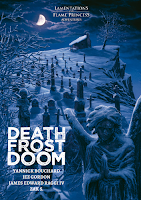With the recent release of a POD copy of the Rules Cyclopedia, there's been a lot of looking back at the Basic D&D rule set(s) that spawned that early 90s compendium. Retroactively referred to as BECMI (for Basic/Expert/Companion/Master/Immortal) these were the Basic D&D rules released as five boxed sets in the mid-80s by TSR, and written by Frank Mentzer. An army of kids grew up with this version of the game, myself included. Although I owned Moldvay's box for less than a day, this was the boxed set that taught me how to play the game. Many of us transitioned to AD&D, but in name only. We may have pulled monsters from Fiend Folio and magic items from the AD&D DMG, but the engine we ran the game on was Basic.
I never bought the RC when it was initially released, and I don't think I'd buy it now. That book, its layout, and its art hold no nostalgia for me. The OSR clones I have now do all the things I want, generally with better organization. I revisited my old BECMI books a few weeks ago and tried to see if they still held the same magic for me. What I found was surprising.
Taken as a whole the BECMI, or RC, rules system is pretty crunchy. There are a lot of rules in this game which increase as characters progress to higher levels, more than I am currently interested in running. It's not just the number of rules either; it's what the rules cover that leaves me cold. Details about hirelings, strongholds, jousting tournaments, weapons mastery - some these are holdovers from 1974, but they have absolutely nothing to do with the reasons I play the game. Also, the packed, three-column layout of these books isn't very reader-friendly and much of the Elmore/Easley artwork hasn't aged well for me.
I can't imagine going back to descending AC, alignment languages, race-as-class, demi-human level limits, pre-AD&D PHB thieves skills, etc. I mean I could go back and it would be fine, but I don't have to, so why would I? Like most nostalgia, what we remember is a freshness that has long since faded, and one we desperately wish to recapture. Looking through these books now makes my remember the childhood bedroom I shared with my brother where I first read them and had my mind blown wide as to the possibilities of the game. As artifacts of my childhood they still hold some charm, but as gaming materials they are of little use to me.
There is one exception. One book among all the sets that transcends nostalgia and still feels like it has relevancy. The Players Manual of Set 1, otherwise known as The Red Box, is perhaps the best introduction to fantasy role playing ever written. It's my belief that when people wax nostalgic about BECMI, Mentzer Basic, or The Red Box, what they're really talking about is this first booklet. The Dungeon Masters Rulebook from the first box, by comparison, is fairly dry, flavorless, and contains little art. The Players Manual, on the other hand, is gold.
The first thing the PM does right is get the new player right into the action. It puts a sword in the reader's hand and has them step into a dungeon. This opening adventure could cynically be called a choose-your-own-adventure railroad, but for people who have never played the game before, this kind of rigid structure is exactly what they need. It also manages to introduce a number of important concepts of the game in along the way in a naturalistic way. By the end of the adventure, you have a pretty good idea of what D&D is about.
The rest of the book fleshes out the rest of the rules need to play. Mentzer's tone is open and familiar. There's no trace of Gygaxian pretension (which I can enjoy as well). You get the sense that Frank is excited for you to play. The organization is genius, and if I'm not mistaken, it marks the first time in a D&D book where each character class is given a spotlight section each complete with an illustration that conveys as much information as the text. The very D&D concept of a Cleric is initially pretty foreign, but Elmore and Easley's illustrations of the mace-wielding holy warrior and the stern, pageboy-cut priest tell you exactly who these people are.
This version of the Basic game doesn't have hieroglyphic mystery of the Holmes edition or the space-disco vibe of Moldvay/Cook/Marsh's B/X (think of Otus' alien dungeonscapes and Willingham's and Dee's flared cuffs). Instead, a very hair metal/chainmail bikini (hello, Clyde Caldwell) atmosphere starts to present itself. Dragonlance's art killed Elmore's work for me, but his art for the Red Box still gets me. The cover painting, of course, is one of the top 10 iconic pieces in the game's history. When we talk of our fondness for Mentzer Red Box, I firmly believe it's that red dragon and the opening excursion into Bargle's hideout that holds sway. Sometimes that's all your looking for.
Subscribe to:
Post Comments (Atom)
GM Notes - Morgansfort Session 14 - Death Frost Doom - Part 2 of 2
So, here stands the final chronicle of my two-year Basic Fantasy campaign. It ended a year ago and I'm just now getting around to fini...

-
Jeff Easley's BECMI Thief I’ve recently decided to run an OD&D game. This, of course, brings with it the age-old question of whi...
-
It is around 11:30 p.m. Father Thelbain acts quickly and has his acolytes clean up the remains of the dead, mute cultist, Brother Malach...
-
So, here stands the final chronicle of my two-year Basic Fantasy campaign. It ended a year ago and I'm just now getting around to fini...




No comments:
Post a Comment